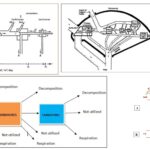Botany 23 Views 1 Answers
Sourav PanLv 9August 22, 2024
What does meristematic tissue do?
What does meristematic tissue do?
Please login to save the post
Please login to submit an answer.
Sourav PanLv 9May 15, 2025
Meristematic tissue plays a crucial role in the growth and development of plants by enabling continuous cell division and differentiation. Its main functions include:
- Cell Division:
- Primary Function: Meristematic tissue is responsible for the production of new cells through mitotic cell division. This process drives the growth of plant organs and structures.
- Details: Cells in meristematic tissue divide rapidly and produce daughter cells that will differentiate into various specialized cell types.
- Growth:
- Primary Growth: Increases the length of shoots and roots. This type of growth occurs at the apical meristems located at the tips of stems and roots.
- Secondary Growth: Increases the girth or thickness of stems and roots. This growth is facilitated by lateral meristems, such as the vascular cambium and cork cambium.
- Formation of New Tissues:
- Differentiation: Meristematic cells differentiate into various types of permanent tissues (e.g., xylem, phloem, epidermis, etc.), which perform specific functions in the plant.
- Example: Cells from the apical meristem differentiate into tissues that make up the plant’s leaves, stems, and flowers.
- Regeneration and Repair:
- Wound Healing: Meristematic tissue can contribute to the repair of damaged plant parts by producing new cells that replace damaged or lost tissues.
- Regrowth: It facilitates the regrowth of plant parts, such as when a plant is cut back or undergoes injury.
- Development of Plant Structures:
- Organ Formation: Meristematic tissues are involved in the development of new plant organs such as leaves, flowers, and roots.
- Example: The shoot apical meristem generates new leaves and flowers, while the root apical meristem contributes to root growth and branching.
Overall, meristematic tissue is essential for plant development, allowing plants to grow continuously and adapt to their environment.
0
0 likes
- Share on Facebook
- Share on Twitter
- Share on LinkedIn
0 found this helpful out of 0 votes
Helpful: 0%
Helpful: 0%
Was this page helpful?




